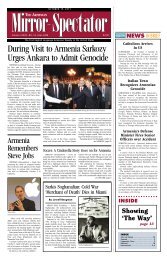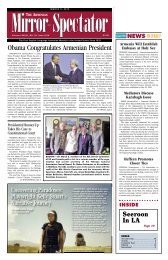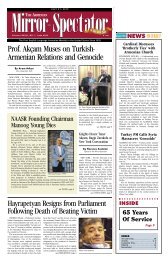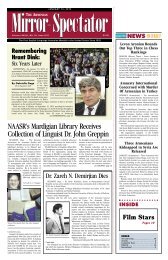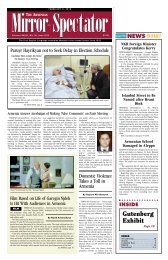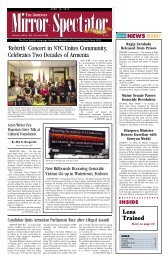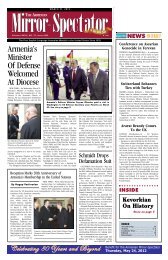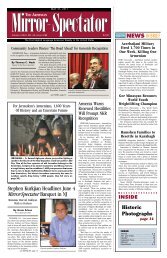The Armenian Mirror-Spectator August 17, 2013
The Armenian Mirror-Spectator August 17, 2013
The Armenian Mirror-Spectator August 17, 2013
Create successful ePaper yourself
Turn your PDF publications into a flip-book with our unique Google optimized e-Paper software.
10 S A T U R D A Y, A U G U S T 1 7 , 2 0 1 3T H E A R M E N I A N M I R R O R - S P E C TAT O RArts & LivingDiyarbakir ExodusChronicles MemoriesOf Three FamiliesBy Gabriella Gage<strong>Mirror</strong>-<strong>Spectator</strong> StaffMADISON, Wisc. — <strong>The</strong> late JosephineMangasarian’s Diyarbakir Exodus is more thanthe story of a singular life; the memoir is anextensive family history — the interconnectedstories of Mangasarian’s mother’s, father’s andhusband’s families — between the years 1895and 1927. In April, the Mangasarian family publishedher unfinished memoir.In 1905, Josephine Mangasarian’s father,Achod Amassian, had accepted a transfer fromhis post at the Diyarbakir telegraph office at themysterious urging of the telegraph office’sdirector and relocated his young family there —roughly a 15-day journey. Her family was inAleppo at the time of the Genocide and deportationsand she watched as countless relativescame to Aleppo seeking refuge. At one time, 20people lived in her family home, many friendsand family who had fled the massacres.Josephine Mangasarian wrote of how she collectedthese stories, saying, “<strong>The</strong> events that Ihave described in this family memoir are alltrue. <strong>The</strong> account of these incidents was relatedto me by the survivors who took refuge inmy family’s home in Aleppo.” Her father’s positionat the telegraph office afforded her accessto secret messages that he decoded corroboratingthe mass killings and much of what shelearned was confirmed by eyewitness accountsfrom family members.<strong>The</strong> publication of Diyarbakir Exodus itselfwas a family endeavor. Josephine Mangasarianhad begun the work with three detailedgenealogical charts completed in her late 80s.Josephine Amassian MangasarianFrom there, she wrote 270 pages by handabout her family and the events during thistime period.Josephine Mangasarian died in 2002 beforeshe could complete the section on the 35 yearsof her life spent in Baghdad, Iraq after they leftSyria. Her son, John Mangasarian, had alreadybegun aiding his mother in her endeavor bytranscribing and typing her handwritten pages.Upon her death, he continued editing andassembling the materials for the book until hepassed the torch to his sister-in-law, ClaireMangasarian, in 2010. In 2011, JohnMangasarian died and she continued editingand assembling the manuscript. ClaireMangasarian, a painter, had experience assemblingmemoirs after she had put together andpublished her own grandfaseeEXODUS, page 12Zarig Baghdadlian and Katherine Sabbagh during rehearsal at the Tekeyan CulturalCenter in Englewood, NJ‘Where’s YourGroom?’Young Group Prepares forHumerous Play on CultureNEW YORK — Among the many concerns <strong>Armenian</strong> parents around the Diasporaface, there is one universal question that stands out: Will our children marry an<strong>Armenian</strong>? Will they be able to continue our <strong>Armenian</strong> heritage?<strong>The</strong> play, “Where is Your Groom?” (Pesad Oor Eh), written, produced and codirectedby Taleen Babayan, raises these questions of identity, assimilation and generationaldivides in a comedic manner.“Where Is Your Groom?” will debut at <strong>The</strong> Players <strong>The</strong>atre in New York’sGreenwich Village on Saturday, October 26. A special guest appearance will be madeby international musician Robert Chilingirian.Taking place in the present day but emulating the voices of older generations, thestory revolves around an <strong>Armenian</strong>-American family who is concerned that theirdaughter, Lara, has not found a suitable <strong>Armenian</strong> pesa (groom). <strong>The</strong> patriarch ofthe family, Koko, enlists his wife, Siroun, son Saro and mother-in law, known endearinglyas “Medz Mayrig,” to find young <strong>Armenian</strong> men for Lara to meet. What ensuesis the introduction of humorous characters as potential suitors who serve as caricaturesof all different “types” of <strong>Armenian</strong>s — from Armenia to America to Iran toTurkey and to Lebanon.“It doesn’t matter where in the diaspora we’re from or what cultural nuances wegrew up with,” said Babayan, 28, who is the producer of a Brooklyn-based newsshow. “At our core, we are <strong>Armenian</strong> and we shoulder the same responsibilities, traditionsand old-word expectations regardless if we’re born in New York, Beirut orIstanbul.”<strong>The</strong> play struck a chord with young <strong>Armenian</strong>-Americans in the New Jersey areaand a cast and crew of over 20 enthusiastic individuals have come together to bringthe play to life. While many are newcomers to the stage, they only needed their culturalties to serve as motivation to be involved in the performance.“From the first moment I heard about the play, I was immediately interested,”said Katherine Sabbagh, 21, a student at Ramapo College who plays the role ofSiroun. “Being with <strong>Armenian</strong>s and expressing my personality through the arts isimportant to me.”“When I heard about this play, I instantly knew I wanted to be involved no matterthe time commitment,” said Zarig Baghdadlian, 23, who works at the HB Groupin New York, and who is playing the role of Lara. “I’m so happy to be part of thisvery relatable play by a talented writer and I’m hoping we’ll take this play to othercities with <strong>Armenian</strong> communities as well.”<strong>The</strong> play has not only given young <strong>Armenian</strong>-Americans the opportunity to meetfellow <strong>Armenian</strong>s and connect with their culture in a new way, it’s also given thosewith an interest in acting a chance to try it out in a friendly atmosphere.“I’ve always wanted to act, so this was a good opportunity to really get into it amongst<strong>Armenian</strong> peers,” said Jiro Khorozian, 25, who works in real estate and who is playingthe role of Jiro the Jeweler. “Maybe this play will inspire me to take up acting.”“When I read the script, I was immediately drawn to the character of the fatherKoko and I knew this was something I wanted to commit my limited free time to,”see PLAY, page 11Northampton’s PoetLaureate Reviews aNew Collection fromDavid KherdianBy Richard MichelsonNORTHAMPTON, Mass. (Valley Advocate) —Four years ago a world-class poet moved toNorthampton, city of poets. Perhaps you readabout it in the newspaper headlines. Or youwould have if poetry was celebrated in the mannerof other arts. But David Kherdian settled inquietly and went about the business of writingpoems, as he had been doing for the previous45 years, and now a new book, Living in Quiet:New and Selected Poems has gathered his life’swork in a beautifully designed edition with awoodcut by his wife, Nonny Hogrogian (moreabout her in a moment), on the cover. It hasbeen published by Deerbrook Editions, a literarypublishing house based in Maine.Kherdian found his voice early. His first volume,On the Death of My Father, of whichWilliam Saroyan correctly said, “<strong>The</strong> title poemis one of the best lyrics in American poetry,”sets out one of the many themes that Kherdianexplored in the more than 20 books that followed.What does it mean to be the Americanbornson of an <strong>Armenian</strong> immigrant father?How does one celebrate the family and heritagethat is in their blood and lineage, while forgingone’s own path and identity?It is a lifelong struggle with no easy answersbut the questioning is all:…Because our relationship did not endwith your death, but continued in this way,my way, on the page and right on throughto the heart of everything that matters,the eternal matter of life on earthand after death. (from “Our Time”)<strong>The</strong>y stare at each otherunable to communicateaware of the abysson one side father Armeniaand on the other, son America(from “<strong>The</strong> Father and the Son”)Originally identified with the Beats and theSan Francisco renaissance of the ’60s, Kherdianquickly went in his own direction, eschewingcliques and “isms” for a style that would servehim well and never waver. <strong>The</strong>re is depth withoutthe need for overt difficulty; there is personalitywithout false humbleness or the flauntingof self, and Kherdian is never afraid to risksentiment in his search for truth. <strong>The</strong>se arepoems hurled into being by the grace of love.Which brings me back to Nonny Hogrogian,a two-time Caldecott-winning artist andKherdian’s partner of 43 years and collaboratoron many books for children. In <strong>The</strong> NonnyPoems, originally published in 1971, many ofwhich are reprinted in the current volume, hecharts their relationship from first meeting — tomarriage — to a life in art lived together.Hogrogian means earth carrierIn the language of our ancestorsAnd now Nonny takes up the toolsOf her new trade, putting theTools of art aside for the moment—To actualize something new, thatIs as old as our people, whoseBeginnings precede Biblical time,Knowing, as she has always known,That to work is to enter mystery…(from “Nonny Hogrogian”)<strong>The</strong>re is so much to recommend in this book.<strong>The</strong> boyhood poems of growing up in Racine,Wis. take on some of the subject matter of USPoet Laureate Phil Levine’s Detroit and itsindustrial landscape. But while Levine’s work issee KHERDIAN, page 13



